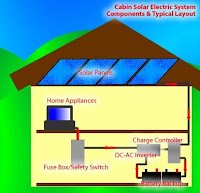

100 WATT thermo couples attached to a wood furnace. The thermo couples begin producing a DC current when the furnace boiler reaches a surface temperature of 250° F. The current is used to maintain a battery charge to operate DC equipment or AC adaptive separate circuit. The furnace is also equipped with water heating thermosiphon circulating coil that subsidizes two flat plate solar collectors.
During the colder seasons when outside temperature is lower and use patterns are usually highest, the extra space heating from carefully selected hardwood help to lower demands on other system components. We illustrate this relation superimposed over time with winter time use pattern. Related patterns based on a typical early spring day at the cabin using solar energy with outside temperature averaging 60 degrees. This method will maintain a well insulated 40 gallon tank at a average temperature of 115° F. What is so eloquent about this system is there are no pumps or the use of electricity to operate the system. The sun's heat drives the solar collector as hot liquid rises it is displaced with the cooler liquid. The hotter the Sun' heat the faster the liquid travels around the loop. The same is true with the wood furnace. Heat drives the hot water around the system thus creating the thermosiphon effect. The furnace heats the water directly whereas a anti-freeze solution in a heat exchanger is used for the solar collectors due to the chance of freezing in the winter time.
1000 WATT Photovoltaic (PV) Direct current generating system. The PV Solar cells produce electricity year round. The best season is between March 20 - September 23 intensifying during summer. Solar cells produce maximum energy during the hours of 9 a.m. - 4 p.m. on sunny days. Energy production is highest during low human demand use hours. This device is excellent for direct applications, ( Cells wired directly to a DC load ) or charging DC batteries for inverted AC electrical circuits during home time energy use hours. The PV average daily energy characteristics is superimposed on summertime human use pattern. Relationship of Photovoltaic output to pattern of energy use on a sunny day. The output can be adjusted to actual human demand usage by adding more PV modules until the desired electrical current is reached.
Efficiency is also added by adding a sun tracking device to direct the array towards the incoming solar rays. One good solar direct application for instance is operating DC powered ventilation fans or DC pumps for evaporating cooling on hot summer days. Below is the link to the actual data gathered during the experiments at the Sol-Era Enviro-Shelter Test Site. ( Notice click on, " older post " at the bottom of the page to see the complete paper )



1 comment:
i really appreciate your blog. it is very interesting and informative.
Residential Solar Power Systems
Local Solar Panel Installers
Post a Comment